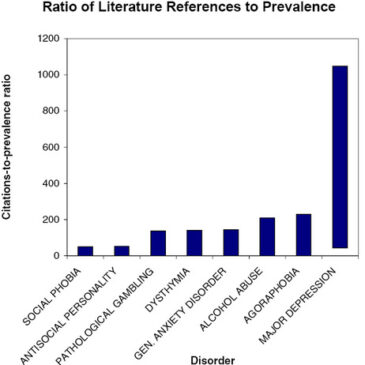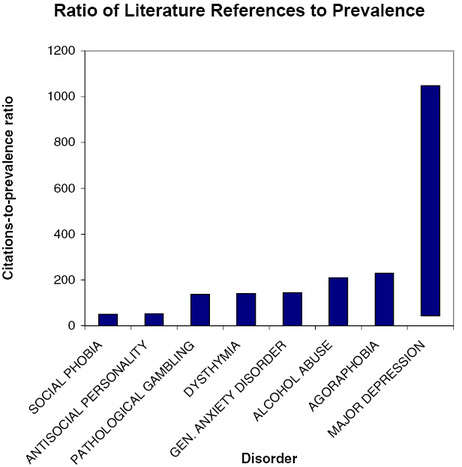Last year, the WAGER examined trends in gambling studies research across three decades [WAGER 4(40)]. Sprock and Herrmann (2000) used a similar approach to examine the frequencies with which specific psychiatric disorders occur in the literature [1]. They conducted a query of the PsychInfo database, searching for journal articles published between 1991 and 1997. Major depressive episodes and schizophrenia appeared most frequently in the database, with 12,749 and 10,722 articles, respectively. Pathological gambling disorder appeared 219 times in the literature, placing it near the center of the distribution of frequencies.
That depression should be such a popular topic of inquiry is not surprising, given its high prevalence in the general population (12.7% lifetime [2]). But looking at the raw number of citations for each disorder only tells part of the story. What happens if we compare the raw number of citations for a particular disorder to the prevalence of that disorder in the general population? To operationalize this question, we divided the number of citations for selected disorders (as reported by Sprock & Herrmann) by the prevalence of the disorder (as reported by the National Comorbidity Survey [2]). The result is a ratio of citations-to-prevalence. Thus, a large ratio value means that the relative number of articles published is high given the proportion of people who actually have the disorder. The chart below presents the results of the WAGER’s calculations. Since the National Comorbidity Survey did not measure the prevalence of pathological gambling, we used the figure presented by Shaffer et al. (1999) [3].
Although pathological gambling appears only 219 times in the literature between the years 1991 and 1997, its ratio is relatively low. This implies that a comparatively large amount of research has been devoted to pathological gambling given the proportion of the population that has the disorder. The ratio for major depressive episode is even higher. There are over 10,000 references to depression in the literature, which is disproportionately high given the base prevalence of depression compared to the other disorders.
The ratio calculated for pathological gambling is on par with those for antisocial personality disorder, social phobia, dysthymia, generalized anxiety disorder, alcohol abuse, and agoraphobia. While it may surprise some observers, this result suggests that pathological gambling has received its fair share of scholarly attention compared to other disorders with similar or higher prevalences.
References
[1] Sprock, J., & Herrmann, D. (2000). Relative size of the literatures for psychopathological disorders: Number of articles pertaining to DSM-IV diagnostic categories. Journal of Clinical Psychology, 56, 491-504.
[2] Kessler, R.C., McGonagle, K.A., Zhao, S., Nelson, C.B., Hughes, M., Eshleman, S., Wittchen, H-U., & Kendler, K.S. (1994). Lifetime and 12-month prevalence of DSM-III-R psychiatric disoerders in the United States. Archives of General Psychiatry, 51, 8-19.
[3] Shaffer, H.J., Hall, M.N., & Vander Bilt, J. (1999). Estimating the prevalence of disordered gambling behavior in the United States and Canada: A research synthesis. American Journal of Public Health, 89, 1369-1376.





